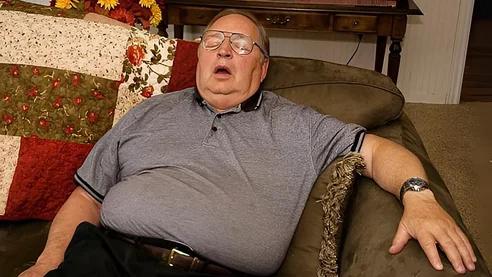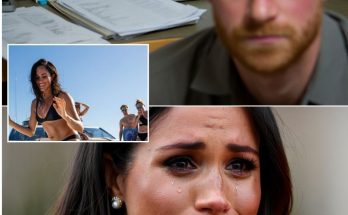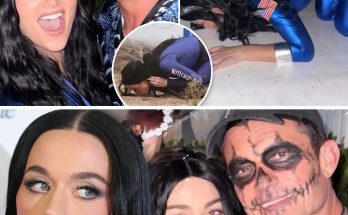Having just turned 22, Lady Louise Windsor has no doubt made her parents, the Duke and Duchess of Edinburgh, very proud.
The eldest child of Prince Edward, 61, and Sophie, 60, is in her final year of studying English at the University of St Andrews – and she’s been tipped to take on a more prominent role in the ‘slimmed-down monarchy’ under the reign of Prince William.
But 22 years ago, there were fears for her – and her mother’s – very survival, since Lady Louise’s birth reportedly brought the Duchess within ’15 minutes’ of death.
Louise, who weighed just 41b 9oz, was delivered via an emergency C-section on November 8 before being immediately whisked away to receive specialist care.
The complications from her premature birth also left the young royal with esotropia – a rare condition which means that both eyes do not look in the same direction.
Sophie, who had married Edward in June 1999 at Windsor’s St George’s Chapel, had longed for a child for many years and was keen to start a family.
After suffering an ectopic pregnancy in December 2021, her dreams of natural conception were slowly diminishing. But, much to the Duchess’ delight, in 2003 she received a positive pregnancy test.
Then aged 38, the mother-to-be had given up her beloved horse riding and was eating a strictly healthy diet to minimise all risks. By November 2003, with a month still to go before her due date, her pregnancy seemed to be progressing well.

Just over 22 years ago, the Duchess of Edinburgh welcomed the Royal Family ‘s so-called ‘secret weapon’ – Lady Louise Windsor. But in November 2003, both her and her mother’s lives were placed at terrifying risk following a traumatic birth
What should have a joyous occasion came distressingly close to a royal tragedy – with a highly traumatic birth leaving the Duchess reportedly just ’15 minutes away from death’ while in the emergency room
Indeed, she appeared so well that Edward boarded a 12-hour flight to Mauritius for an official Remembrance Day visit, entirely unaware that his first child was just days away from arrival.
On November 8, Sophie started to experience crippling abdominal pains while 38 weeks pregnant as she was watching Saturday night TV at the couple’s large Surrey home, Bagshot Park.
With the pain rapidly progressing, she placed an urgent call to the late Queen’s obstetrician, Sir Marcus Setchell, who instructed her to immediately visit her nearest hospital.
However, due to some confusion over the call, police officers, rather than medics, turned up, resulting in a potentially calamitous 30-minute delay.
The late Monarch’s former press secretary, Alisa Anderson, previously described the terrifying moment she received a call from Mr Setchell who quickly made clear the severity of the situation.
Speaking on A Right Royal Podcast, she recalled: ‘He said, “I’m in a police car on my way to Frimley Park hospital. You better come”. So I thought, crikey.
‘So, I ordered a taxi, let my husband do the washing up, which I think was a first in our marriage, and got myself down to Frimley Park, but the Earl of Wessex was abroad on an official visit.
‘They couldn’t get a hold of her parents. So basically, it was just me and Marcus and the courtiers in the hospital. It was so dramatic.’

Young Louise, who weighed just 41b 9oz, was delivered via an emergency C-section on November 8, 2003. The severe complications from her premature birth left the young Royal with esotropia – a rare condition which means that both eyes do not look in the same direction
As the Duchess raced to hospital, both her life and the life of her newborn baby were hanging perilously in the balance. While Edward had been contacted in Mauritius, he was unable to return until the next day, leaving the expecting mother on her own.
After eventually arriving at Frimley Park Hospital, medical teams discovered that Sophie was in urgent need of an emergency caesarean having shown signs of acute placental abruption, meaning that the placental lining had separated from the uterus.
With a likelihood of colossal blood loss for the mother, alongside an increased chance of a stillbirth, Sophie’s condition was so advanced that it placed both her and the baby at risk of death.
Sir Marcus, who had rushed to the hospital at great speed, oversaw the vital operation, undertaken by surgeon Sukhpal Singh, gynaecologist Anne Deans and midwife Adrienne Price.
Miraculously, Lady Louise was born at 11.32pm on November 8, but was immediately taken from her mother to St George’s Hospital in Tooting to receive neonatal unit specialist care.
Meanwhile, Sophie’s condition was quickly deteriorating.
The Duchess, who was rapidly losing vast amounts of blood and had even slipped into a semi-conscious state, eventually required nine pints of blood via a transfusion, with doctors fearful that she may not survive.
Meanwhile, Edward was unable to make it back to the UK until the following evening. Having been entirely unaware of the unfolding situation, he was later said to have gone ‘white as a sheet’ when he discovered the precarious condition of both his wife and newborn daughter.

Sophie, who was rapidly losing vast amounts of blood and had even slipped into a semi-conscious state, eventually required nine pints of blood via a blood transfusion, with doctors fearful that she may not survive. Meanwhile, Lady Louise was in a neonatal unit receiving care

Edward was unable to make it back to the UK until the following evening. Having been entirely unaware of the unfolding situation, he was later said to have gone ‘white as a sheet’ when he discovered the precarious situation both his wife and newborn daughter were in
For six days, Sophie was unable to be moved or see her new baby, with even the late Queen, who held an extremely close bond with the Duchess, said to have broken royal protocol to secretly visit her critically ill daughter-in-law in hospital.
When Sophie was finally reunited with her newborn baby, her feelings of elation and relief were almost indescribable.
Likewise, for Prince Edward, it marked a welcome end to what had been a rather distressing ordeal. Speaking to reporters that had gathered outside of the hospital, he poignantly shared how it had been a ‘fantastic day’ and certainly one ‘of great relief and joy’.
He added: ‘It’s difficult to explain what it is to be together as a family for the first time.’
But the new father was no doubt shaken by the experience, describing how while he had felt both ‘shocked and delighted at the news’, he was ‘obviously very sorry that I was not able to be part of it’.
Following 16 days in hospital, Sophie was finally granted permission to return to Bagshot Park, with images capturing the moment the new mother exited the building alongside her husband who carefully cradled their baby.
Upon returning home, the Duchess quickly informed her friends that any plans she had made had ‘gone out the window’ and had recalled to her nearest and dearest how the birth had been ‘the most frightening time of her life’.

Just three months after her birth, Lady Louise’s left eye was beginning to turn inwards, an indication that she could be suffering from esotropia. She was later treated with surgery and now has ‘perfect’ sight
But the new parents’ ordeal did not stop there. Just three months after her birth, Lady Louise’s left eye was beginning to turn inwards, an indication that she could be suffering from esotropia – a rare condition that causes eyes to look in different directions.
To treat the condition, surgery is required. However, Sophie was understandably reluctant to put her baby through any more treatment at such a young age.
She went on to receive a partial successful surgery at 18 months old, followed by a second operation in 2013 that successfully saw her obtain ‘perfect’ sight.
And while Sophie’s ectopic pregnancy had reduced the chances of natural conception, the Duchess went on to have a second child without any medical assistance – James, Earl of Wessex, was born on December 17, 2007 by planned Caesarean at Frimley Park.
However, while the birth went smoothly, James shortly had a worrying spell at Great Ormond Street Hospital for what later turned out to be a milk allergy.
The harrowing impacts of the traumatic and near-fatal birth Sophie had with Lady Louise have undoubtedly lingered beyond that fateful day.
Indeed, one friend later told the Mail on Sunday that Sophie ‘has never got over it’, adding that it has ‘completely reshaped her character and affected how she relates to her children’.
In 2014, the Duchess was seen breaking down in tears after making a return visit to Frimley Park Hospital to open its neonatal unit and speak with staff.

While Sophie’s ectopic pregnancy had reduced the chances of natural conception, the Duchess went on to have a second child without any medical assistance – James, Earl of Wessex, was born on December 17, 2007 by planned Caesarean at Frimley Park

The harrowing impacts of the traumatic and near-fatal birth Sophie had with Lady Louise have undoubtedly lingered beyond that fateful day. In 2014, the Duchess was seen breaking down in tears after making a return visit to Frimley Park Hospital to open its neonatal unit
Sophie tearfully met the Head of Midwifery Adrienne Price, who had been present at the birth of both of her children, issuing a sincere mark of thanks to the staff, adding: ‘your service is the difference between life and death’.
In a highly emotional speech, she continued: ‘I know all the staff are really keen to get everything started. It is a great working environment, and the results you are having are a testament to this investment.
‘It has been something really important in my life, and so I thank you again for inviting me here today.’
The Duchess’ harrowing experience has also seen her use her royal platform for advocacy work – resulting in her becoming a committed global ambassador for the International Agency for the Prevention of Blindness (IAPB).
As her children grew older, Sophie would go on to be described as possessing a ‘caring but quite formal’ style of mothering, in part influenced by her late mother – Mary Rhys-Jones – who sadly died aged 71 in 2005 following a short battle with colon cancer.
The Duke and Duchess have also remained insistent on their children having as normal an upbringing as possible, within the obvious boundaries of the royal fold and a 120-room mansion.
Indicative of her commitment to creating a ‘normal’ childhood, Sophie would do the school run as often as possible.

Sophie and Edward have tried to raise their children with as normal an upbringing as possible. As Lady Louise comes towards the end of her studies at St Andrew’s University, royal experts have suggested she could play a leading role amid a challenging time for the Monarchy
Louise and James were also deliberately not given HRH titles at birth. When Louise turned 18, she could have chosen to change to the title of Princess, however chose not to, with her brother James expected to follow suit.
As Lady Louise comes towards the end of her studies at St Andrew’s University, royal experts have started to look towards the young royal as a possible figure who could help to inject a new sense of modernity into the Firm as it evolves.
Despite discussion of a ‘slimmed-down’ Monarchy, it is hoped that a further integration of Lady Louise, eighteenth in line to the throne, could help to advance the Royal Family’s legacy while resonating with the younger generations.
But as we look towards the pivotal role Lady Louise could play in future, many will no doubt be reflecting on how close we could have come to losing such an integral figure.





